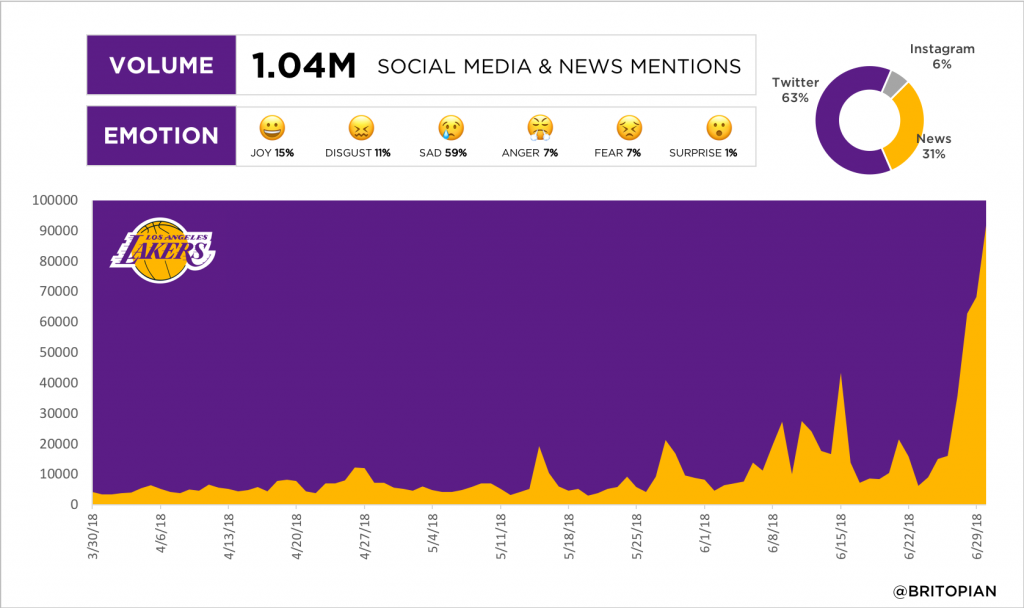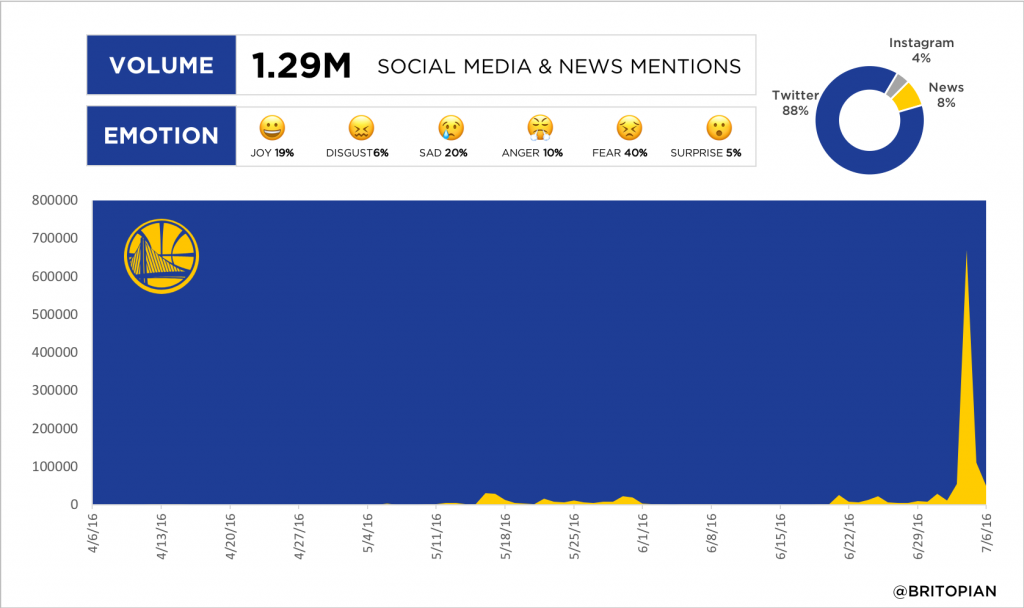Scroll down to see the Brandwatch sentiment analysis of the Lebron James hype of joining the LA Lakers in 2018.

Do you ever wonder what people are saying about your company online? Are you curious if customers are happy with your products and services? If so, you may want to consider sentiment analysis to fully understand the sentiment of the conversations. You can also do a content analysis in marketing research that will provide context and meaning.
What is Sentiment Analysis?
Sentiment analysis is the process of identifying and measuring the emotional tone of a text. It can be used to gain insights into customer sentiment, track brand reputation, and more. This is important because it can help you decide how to improve your products and services and understand what people are saying about you online. Brands started using sentiment analysis to track customer sentiment a few years ago, but it has become more popular with the rise of conversations on social media.
How to Do Sentiment Analysis
There are a few different ways sentiment analysis can be performed. The most common method is through the use of natural language processing (NLP). This involves using algorithms to analyze text and identify sentiment. Another way sentiment analysis can be done is through manual review. This is where people read and analyze text to identify sentiment. This method is often used for smaller data sets.
Sentiment analysis can be performed using various tools and methods. If you’re interested in trying it out, there are a few things you’ll need to do first.
- Choose the right tool or method for your needs.
- Gather your data. This can be done by scraping social media, reading reviews, or anything else that will give you data to work with.
- Perform the sentiment analysis. This will involve using the chosen tool or method to analyze the data and identify sentiment.
- Interpret the results. Once sentiment has been identified, it’s important to interpret it. This can be done by looking at sentiment over time, comparing different data sets, or anything else to help you understand the results.
Sentiment analysis is a powerful tool that can be used to gain insights into customer sentiment, track brand reputation, and more.
Brandwatch Sentiment Analysis Example
I’m a Lakers fan. And I’m hyped that King James has joined the squad. I watched Sportscenter for most of last night because I was in shock and still wasn’t sure it was true. My social media feeds blew up with my Lakers posse posting their pure excitement about the King and our quest to get more rings. Others (mostly Warriors fans) criticized the move, probably because they were scared that LeBron moved out west.
All this conversation prompted me to look at some data. I did a Brandwatch sentiment analysis on the last three months of conversation about LeBron joining the Los Angeles Lakers. Since March 30th, over 1 million social media posts (Twitter & Instagram) and news articles combined. You can see the conversation distribution below – Twitter also dominated the discussion with much news coverage.
I also looked at Brandwatch sentiment analysis to try and understand the mindset of the folks posting about LeBron and the Lakers. Honestly, I didn’t spend much time drilling down because the data scientists at Crimson do a pretty good job at clustering/hand-coding the language and emotion. Here’s what I did find after 20-3o minutes of reading through the content, trying my best to filter out the trolling:
- Joy: People like me, happy & counting down until we win more championships.
- Disgust: Haters gonna hate.
- Sad: Most Cavs fans are upset about LeBron’s decision to leave for the West.
- Anger: Other Cavs fans expressing hate for LeBron leaving the team again.
- Fear: Fans of other teams in the West are afraid because the Lakers just became contenders.
- Surprise: Many sports journalists were surprised about LeBron’s decision.
I love seeing Lakers fans rally behind the decision, and I’ll be tracking the conversation volume when the season starts and when we make the finals next year too! Below is more on the Brandwatch sentiment analysis and more data.

Since I am surrounded by Warriors fans and they were in a similar Brandwatch sentiment situation with Kevin Durant a few years ago, I wanted to compare Kevin Durant’s announcement from back in 2016.
There’s more volume, but I was surprised at the lack of news coverage about KD joining the Warriors (only 8%). Twitter dominated, and the conversation there was similar to what happened with the decision last night–joy from loyal Warriors fans and, of course, “haters gonna hate.” I fell into that ladder category. This is a smart way to increase brand awareness on social media.
In reviewing the emotion and sentiment analysis, here’s what I found about the KD announcement:
- Joy: Mostly #DubNation excited for the new super team.
- Disgust: Me = “There’s now an asterisk next to KD’s name for his rings.”
- Sad: Most OKC fans are upset about KD’s decision to take the easy way out.
- Anger: Other OKC fans posting photos/videos burning KD’s jersey.
- Fear: Fans of other teams in the West are afraid because of the super team.
- Surprise: Many OKC sports journalists were extremely surprised.

I am a biased Lakers fan, but at the end of the day, KD’s announcement generated more buzz (less news coverage) than what transpired over the last 3 months. Brandwatch is one of many social media listening tools that you can use to content analytics like this. Hope you enjoy this post, and for more insights like this, please subscribe to my Youtube channel to be notified when new videos are added.
